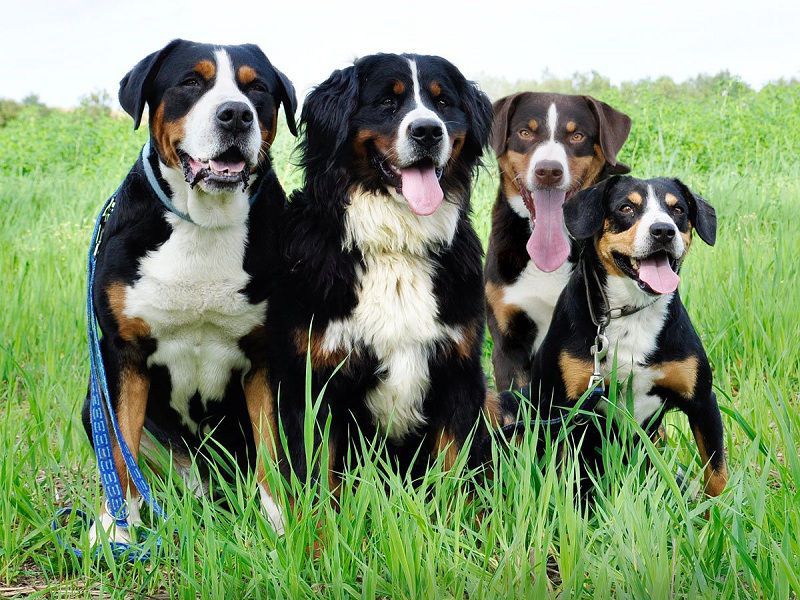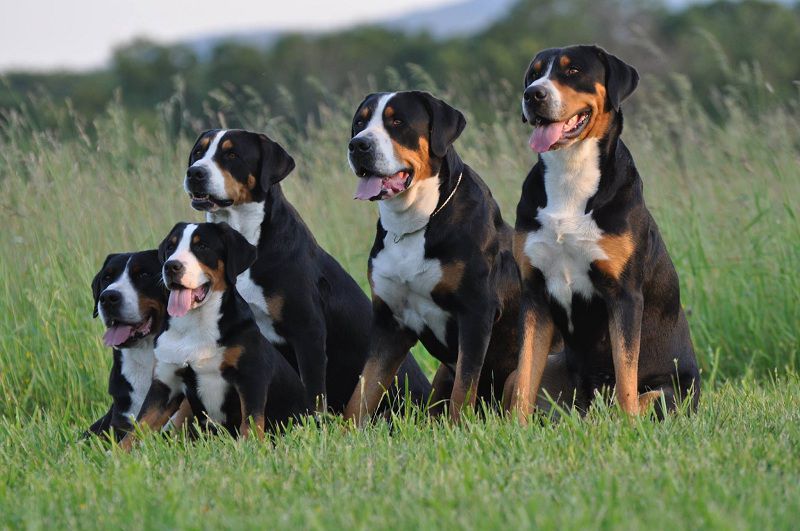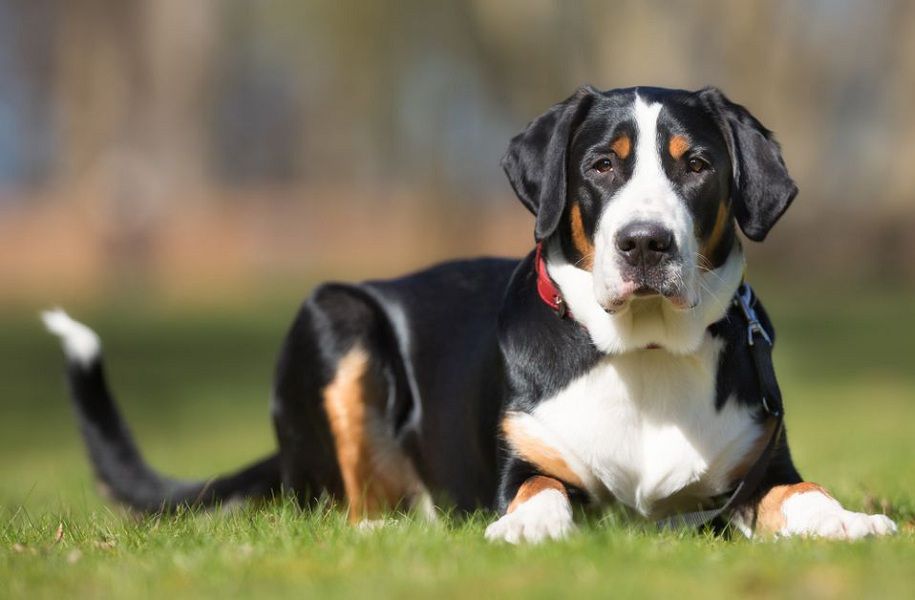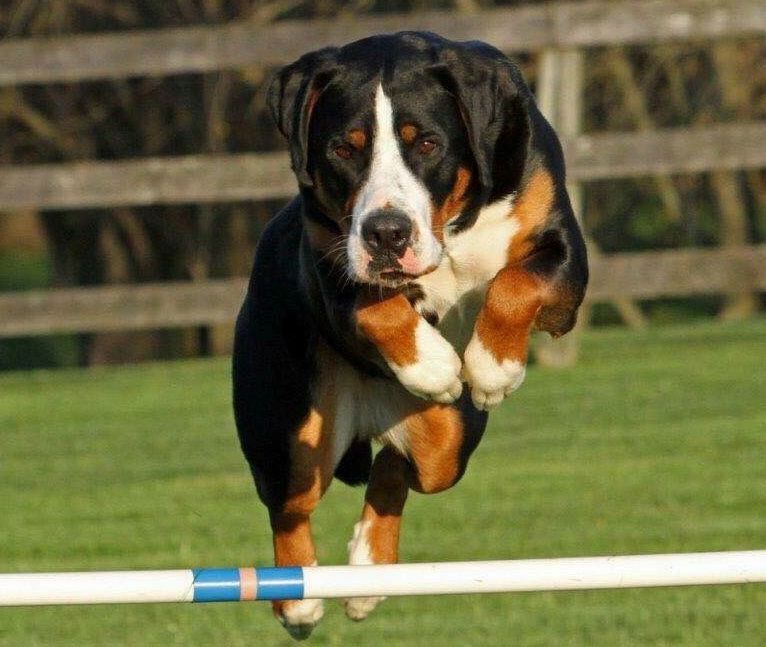The Great Swiss Mountain Dog is an alpine breed of dog, the largest of the breeds of its group. Sometimes it is simply called “gross.” It is one of the smartest and artistic breeds of a dog. The dog loves its owner and is not afraid of any climatic changes. It will not run from its owner but does not like its freedom to be limited by a chain or a fence.

Characteristics
The Swiss mountain dog is a strong, hardy dog, accustomed to living in the open mountain air, dragging weights and moving long distances.
Color: three-color; black is the main shade with a light brown. There is a symmetrical white pattern on the chest and neb. White socks and a collar are allowed
General appearance:
- The dog has muscular chest and strong limbs, the front legs are widely spaced.
- The tail is heavy, hanging down in a calm state; a tail raised above the back and bent by a ringlet is considered a vice.
- The head is powerful, large.
- Ears hanging, black.
- Eyes are brown in shades, from light hazel to dark chestnut, with an almond-shaped incision.
- The nose is big, black.
The disadvantages of the breed:
- blue eyes;
- long or too short coat;
- clubfoot;
- visible light undercoat, violation of the general color gamut;
- aggressiveness and cowardice.

History of The Great Swiss Mountain Dog Breed
The origin is still reliably unknown. Researchers adhere to the hypothesis that the ancestors of this breed appeared in the mountains of the Alps with the Roman legionnaires 2,000 years ago. Further signs were found in the now extinct greater mountain dogs that accompanied the alpine shepherds.
For a long time, the selection criterion was official datac and nature, but in accordance with external signs of the grosses, they began to display only at the start of the XX century.
The dog was used in three ways:
- a shepherd dog with sheep farmers and slaughtermen;
- traction dog;
- guard at the peasants.
In 1908, the dog was first introduced at the show for dogs as the Bernese Mountain Dog. When a professor A. Heim saw it, he came to the conclusion that that ‘s the dog of a similar, but new breed.
Over the next few years, pure breeding experiments were conducted, and already in 1912 the first Breed Club was founded in Switzerland. During the Second World War, grosses were used to help alpine shooters – they brought ammunition and medical bags.
The first Swiss appeared in Russia in the early 2000s. They were graduates of German nurseries, which were supervised by the mountain dog Club of Germany.
Behavior and temper
This type of dogs rightfully bear the title of one of the most harmonious. They are calm, reasonable, self-confident and very social. The Swiss do not choose one owner, he becomes attached to the whole family and protects it as his own pack.
Positive sides:
- friendliness;
- fidelity;
- curiosity;
- excellent learning ability;
- calm, balanced temperament;
Negative features:
- stubbornness, waywardness;
- difficulty in contacting strangers.

The dog and man
It is very difficult to live in urban conditions for this dog due to how big it is and constant need for serious physical exertion. It is better to begin a Swiss for those who have a private house in the countryside. These dogs live with pleasure in the open air, but the owners need to arrange for them a reliable shelter from the cold, sun and wind.
In no case can the Swiss be kept on a chain and in closed pens – this causes the development of neurotic conditions, increases aggressiveness and prevents the dog from realizing what it is really good at. Today, the Swiss are a companion dog, a companion dog, a family member and a reliable friend.
Grosses get along well with children, protect them from dangers and allow them to play with themselves. This feature is a legacy of the time when the Swiss were shepherd dogs.
Gross also makes contact with other pets. The dog feels comfortable even if there are many people and animals in the house.
Support and looking after
It takes a lot, a lot of physical activity! The Sennenhund requires a large amount of space.
Wool needs to be combed regularly. It is not recommended to wash the dog, but it is recommended to clean it with a special rubber brush.
The dog requires a careful approach to the diet:
- regular feeding is important;
- after eating, it needs at least 1.5 hours of rest;
- foods high in fat can lead to overweight, which is unacceptable for the Sennenhund – this is very harmful for their joints;
- high protein foods often cause skin allergies;
- puppies need fortified supplements for proper skeleton formation.
Training
Despite the fact that many dog handlers note the willfulness and even some stubbornness of this type of a dog, they lend themselves to training quite easily – the main thing is to find a common language with your dog. Grosses need constant mental exercise and emotional contact with the host. If they are deprived of such training, then their intellectual abilities are greatly reduced.
Even though now they are practically not used as shepherd and service dogs, they did not lose their skills. A domestic dog will be happy to carry sledges with children, trolleys with a small load, and vigilantly monitor the safety of the owners.
Health and duration of life
The Sennenhunds live only 10-12 years.
Common diseases of the breed:
- Diseases connected with joints and the musculoskeletal system as a whole.
- Cardiovascular pathology.
- Allergic and dermatological diseases.
- There are cases of epilepsy.
Heart diseases due to the great size. In order to reduce the risk of these pathologies, you need to carefully monitor dog weight: follow a diet and exercise.

Feeding
The impressive dimensions of a greater mountain dog oblige the owner to carefully consider the choice of the four-legged comrade’s menu. On the one hand, it is advisable not to overfeed the dog, as being overweight is always a problem with well-being, and on the other hand, you need to put enough nutrients in a serving. The diet must certainly include, in addition to meat and offal, vegetables, fruits, dairy products and eggs. Of cereals – brown rice, buckwheat. Industrial feeds are exclusively premium, balanced for dogs of large or giant breeds.
Choosing a Great Swiss Mountain Puppy
You should not buy a puppy in the market, as purebred dogs are simply not there. Therefore, it is necessary to buy a puppy only in specialized pedigree nurseries, there are a lot of them, so finding them will not be difficult, while natural competition always leads to an increase in the quality of puppies. You should choose a puppy only in the environment in which s/he lived and grew up, since only there s/he will behave naturally, which will give you the opportunity to draw conclusions more or less objectively. When choosing a puppy, pay attention to the parents, well, everything is simple with mom, but you can’t see dad, for this ask for copies of his documents, letters indicating the awards received. In the documents, pay attention to the fact that parents are not closely related, as this is not always good.
How much do Great Swiss Mountain Puppies Cost?
It should be noted that this breed is very expensive, so as for puppies in the markets, you can buy a puppy in the range of 350-500 US dollars, in young clubs and private breeders the price will increase to 550-700 US dollars.
As for the really pedigree kennels, then the puppies are the most expensive, so the price for a 2-3 month old puppy is in the range of $ 1,500, sometimes, when it comes to elite lines, the price can reach $ 3,000 or more.
About the author
Melisa Marzett is a dreamer but very practical at the same time. She has always wanted to write and her dream came true. Now, she is a successful freelance writer who works on articles on this and that currently writing for revise services. She is much of a traveler, a volunteer and a fitness enthusiast.
> You May Also Like:
- Saint Bernard price & cost range. Where to buy Saint Bernard puppies?
- Great Pyrenees price range. Where to find Great Pyrenees puppies for sale?
- Newfoundland dog price & cost range. Where to buy Newfoundland puppies?
